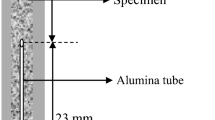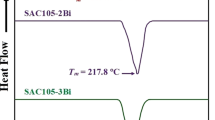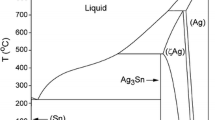Abstract
With low liquidus temperatures, low raw material costs, and non-toxicity, Sn-Bi low-temperature solders are promising candidates for the replacement of the currently widely-used lead-free solders in situations in which process temperatures have to be reduced. Electrical resistivity is one of the most important properties of solder alloys, as one of their primary functions is to conduct electrons between the connected components. The electrical resistivity of an alloy of a given composition at a specific temperature and pressure is affected by the microstructure and the crystal structure of the phases present. For Sn-Bi solders, the solubility of Bi in Sn is highly temperature-sensitive and increases from 3 wt.% at room temperature to 21 wt.% at 139°C, the eutectic temperature of the Sn-Bi system. As the temperature increases within that interval, Bi will dissolve in Sn, while it will precipitate as the temperature decreases. The resulting significant changes in the overall microstructure and the lattice parameters of the Sn phase can be expected to affect the electrical resistivity. In this study, the electrical resistivity of hypo-eutectic Sn-37wt.%Bi and near-eutectic Sn-57wt.%Bi alloys was measured as a function of temperature and the temperature coefficient of resistance (TCR) calculated. It was found that the electrical resistivity increases linearly with increasing temperature up to 70°C, while above 80°C, a deviation from the linear relationship was observed. This deviation is attributed to the rapid dissolution of Bi in Sn at 80°C and above.







Similar content being viewed by others
References
H. Kang, S.H. Rajendran, and J.P. Jung, Low melting temperature Sn-Bi solder: effect of alloying and nanoparticle addition on the microstructural, thermal, interfacial bonding, and mechanical characteristics. Metals 11(2), 364 (2021).
F. Wang, H. Chen, Y. Huang, L. Liu, and Z. Zhang, Recent progress on the development of Sn–Bi based low-temperature Pb-free solders. J. Mater. Sci. Mater. Electron. 30(4), 3222 (2019).
S. Cheng, C.-M. Huang, and M. Pecht, A review of lead-free solders for electronics applications. Microelectron. Reliab. 75, 77 (2017).
K. Sweatman, T. Nishimura, T. Akaiwa, and P. Naraynanan. Optimizing solder alloy composition for low temperature assembly. SMTA international conference (Rosemont, IL, USA, 2019).
S. Mokler, R. Aspandiar, K. Byrd, O. Chen, S. Walwadkar, K.K. Tang, M. Renavikar, and S. Sane. The application of bi-based solders for low temperature reflow to reduce cost while improving SMT yields in client computing systems. SMTA international conference (Rosemont, IL, 2016).
H. Fu, R. Aspandiar, J. Chen, S. Cheng, Q. Chen, R. Coyle, S. Feng, B. Hardin, M. Krmpotich, S. Mokler, J. Radhakrishnan, M. Ribas, B. Sandy-Smith, K.K. Tang, G. Wu, A. Zhang, and W. Zhen. Inemi project on process development of BISN-based low temperature solder pastes—Part II: characterization of mixed alloy BGA solder joints. 2018 Pan Pacific Microelectronics Symposium (Pan Pacific, 2018).
Inemi. Bisn-based low-temperature soldering process and reliability. Available from: http://www.inemi.org/bi-sn_based_low_temp.
Q.C. Hao, X.F. Tan, Q.F. Gu, K. Sweatman, S.D. Mcdonald, and K. Nogita, The effects of temperature and solute diffusion on volume change in Sn-Bi solder alloys. JOM 74(4), 1739 (2022).
B.-J. Lee, C.-S. Oh, and J.-H. Shim, Thermodynamic assessments of the Sn-In and Sn-Bi binary systems. J. Electron. Mater. 25(6), 983 (1996).
X.F. Tan, Q. Hao, Q. Gu, S.D. Mcdonald, K. Sweatman, M. Bermingham, and K. Nogita, The effects of Sb on the lattice and microstructure characteristics of hypo-eutectic Sn-Bi alloys. Mater Charact 201, 112934 (2023).
X.F. Tan, J. Zhou, S.D. Mcdonald, M. Ikeda, and K. Nogita. Evolution of the Sn-Bi solder microstructure vs. temperature–an in-situ scanning electron microscopy study. in International conference on electronics packaging (Kumamoto, Japan, 2023).
X. Ye, L. Tao, S.D. Mcdonald, X.F. Tan, K. Sweatman, and K. Nogita. The effects of room temperature ageing and solution treatment on mechanical properties of Sn-37wt.%Bi and Sn-57wt.%Bi. in international conference on electronics packaging (Kumamoto, Japan, 2023).
I.C. Ezenwa, R.A. Secco, W. Yong, M. Pozzo, and D. Alfè, Electrical resistivity of solid and liquid Cu up to 5 gpa: decrease along the melting boundary. J. Phys. Chem. Sol. 110, 386 (2017).
D.S. Mclachlan, M. Blaszkiewicz, and R.E. Newnham, Electrical resistivity of composites. J. Am. Ceram. Soc. 73(8), 2187 (1990).
D.S. Mclachlan, An equation for the conductivity of binary mixtures with anisotropic grain structures. J. Phys. C Solid State Phys. 20(7), 865 (1987).
Y.-A. Shen, S. Zhou, J. Li, K.N. Tu, and H. Nishikawa, Thermomigration induced microstructure and property changes in Sn-58Bi solders. Mater. Des. 166, 107619 (2019).
F. Hadian, J. Flores, and E. Cotts, The variation of the electrical resistance and microstructure of snBi based solder joints with current stressing. JOM 74(5), 2139 (2022).
J. Sun, G. Xu, F. Guo, Z. Xia, Y. Lei, Y. Shi, X. Li, and X. Wang, Effects of electromigration on resistance changes in eutectic snbi solder joints. J. Mater. Sci. 46(10), 3544 (2011).
F. Guo, Q. Liu, L. Ma, and Y. Zuo, Diffusion behavior of Sn atoms in Sn58Bi solder joints under the coupling effect of thermomigration and electromigration. J. Mater. Res. 31(12), 1793 (2016).
The engineering toolbox, resistivity and conductivity-temperature coefficients common materials. Available from: https://www.engineeringtoolbox.com/resistivity-conductivity-d_418.html.
T. Nishimura, Lead-free solder alloy and solder joint. (2021). (JP2021162331A).
W.J. Boettinger, C.A. Handwerker, B. Newbury, T.Y. Pan, and J.M. Nicholson, Mechanism of fillet lifting in Sn-Bi alloys. J. Electron. Mater. 31(5), 545 (2002).
S.A. Belyakov and C.M. Gourlay, Recommended values for the βsn solidus line in Sn-Bi alloys. Thermochim. Acta 654, 65 (2017).
J.A. Wu, A. Luktuke, and N. Chawla, Surface precipitation and growth of bismuth particles in Sn-Ag-Cu-Bi solder joints. J. Electron. Mater. 52(2), 801 (2022).
E. Çadırlı, H. Kaya, A. Gümüs, and I. Yılmazer, Temperature-dependence of electrical resistivity of Cd-Sn, Bi-Sn, and Al-Si eutectic and Al-3wt.%Si hypo-eutectic alloys. J. Mater. Eng. Perform. 15(4), 490 (2006).
V.E. Sidorov, S.A. Uporov, D.A. Yagodin, K.I. Grushevskii, N.S. Uporova, and D.V. Samokhvalov, Density, electrical resistivity and magnetic susceptibility of Sn-Bi alloys at high temperatures. High Temp. 50(3), 348 (2012).
M. Li, H. Geng, F. Long, M. Zuo, R. Liu, and S. Lu, Discontinuous structural phase transition of Sn–Bi melts. J. Mol. Liq. 204, 27 (2015).
J.C. Slater, Atomic radii in crystals. J. Chem. Phys. 41(10), 3199 (1964).
G. Langelandsvik, Optimization of electrical conductivity in screw extruded wires. Norwegian University of Science and Technology. Master (2017).
R.E. Hummel, Electrical conduction in metals and alloys, Electronic properties of materials. (Berlin: Springer, 2001), p. 77.
Deutsches Institut Fur Normung E.V. (German National Standard), Resistance alloys. DIN 17471 (1983).
S.K. Case and J.E. Gueths, Anisotropy of the temperature-dependent resistivity of tin between 8 and 300 °K. Phys. Rev. B 2(10), 3843 (1970).
T.-K. Lee, T.R. Bieler, C.-U. Kim, and H. Ma, Fundamentals of lead-free solder interconnect technology (UK: Springer, 2015). https://doi.org/10.1007/978-1-4614-9266-5.
Electronics Notes, Temperature coefficient of resistance. Available from: https://www.electronics-notes.com/articles/basic_concepts/resistance/resistance-resistivity-temperature-coefficient.php.
W.B. Pietenpol and H.A. Miley, Electrical resistivities and temperature coefficients of lead, tin, zinc and bismuth in the solid and liquid states. Phys. Rev. 34(12), 1588 (1929).
S. Shafeie, S. Guo, P. Erhart, Q. Hu, and A. Palmqvist, balancing scattering channels: a panoscopic approach toward zero temperature coefficient of resistance using high-entropy alloys. Adv. Mater. 31(2), e1805392 (2019).
Acknowledgments
The authors acknowledge Mr. Rodney Young from Masters & Young Pty Ltd and Mr. Blair Knight from The University of Queensland for their support on the electrical resistance measurements. The authors would like to acknowledge Dr. Qinfen Gu at the Australian Synchrotron powder diffraction beamline for the support on the in-situ PXRD experiment.
Funding
This work was supported by The University of Queensland, Australia, Knowledge Exchange & Translation fund [2021002690] with Nihon Superior Co., Ltd. and Masters & Young Pty Ltd.; UQ-Nihon Superior Co., Ltd, Japan, collaborative research Grants [2016001895, 2021002341]; Australian Research Council, Australia, Discovery project [DP200101949]; ANSTO Australian Synchrotron beamtime [Grant Number AS211/PD/16842].
Author information
Authors and Affiliations
Corresponding author
Ethics declarations
Conflict of interest
The authors declare they have no conflict of interest.
Additional information
Publisher's Note
Springer Nature remains neutral with regard to jurisdictional claims in published maps and institutional affiliations.
Rights and permissions
Springer Nature or its licensor (e.g. a society or other partner) holds exclusive rights to this article under a publishing agreement with the author(s) or other rightsholder(s); author self-archiving of the accepted manuscript version of this article is solely governed by the terms of such publishing agreement and applicable law.
About this article
Cite this article
Tan, X.F., Hao, Q., Zhou, J. et al. The Effect of Temperature on the Electrical Resistivity of Sn-Bi Alloys. J. Electron. Mater. 53, 1183–1191 (2024). https://doi.org/10.1007/s11664-023-10849-1
Received:
Accepted:
Published:
Issue Date:
DOI: https://doi.org/10.1007/s11664-023-10849-1




